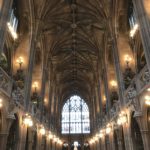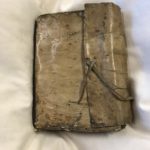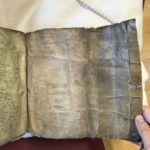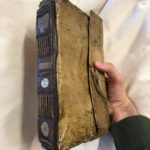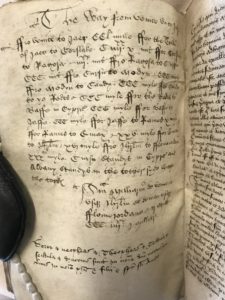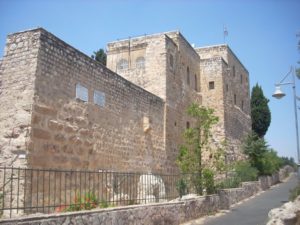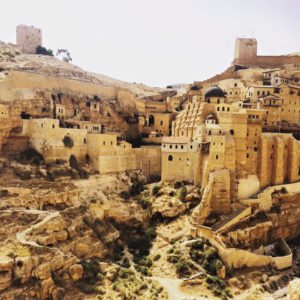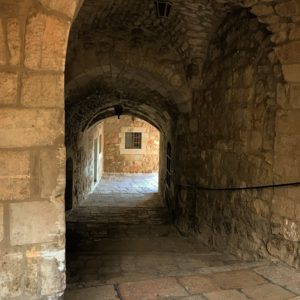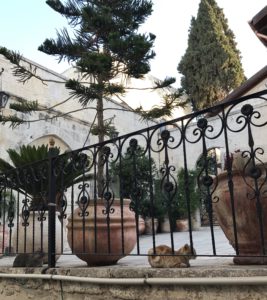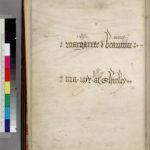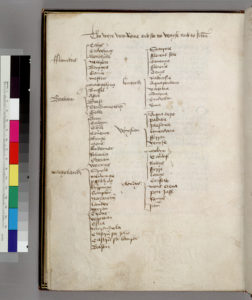
Blog-post author Professor Anthony Bale, Birkbeck, University of London
(@RealMandeville)
One of the original research questions that framed the Pilgrim Libraries research project was the fate of a key library for pilgrims: that of the Franciscans of Mt Zion in Jerusalem. The Ottomans conquered Jerusalem in 1517, and expelled the Franciscans in 1551. A few years later, in 1560, the Franciscans were allowed to return, to a new home at St Saviour’s, in Jerusalem’s Old City. However, very few of the medieval manuscripts seem to have made their way to the new convent. Might the Ottomans have taken manuscripts from Mount Zion, as spoils, or as valuable knowledge about the city? Might there have been books from Jerusalem in the rapidly growing Ottoman imperial archive, housed at the Topkapı Palace in Istanbul?
I recently visited the Library of the Topkapı Palace Museum (Topkapı Sarayı Müzesi), which was the power-base and central archive of the vast empire of Mehmet II (‘the Conqueror’), who ruled as Sultan from 1451 to 1481. The Topkapı library has long been a major resource for those studying Ottoman history and Arabic, Persian, and Turkish manuscripts of the fifteenth to the nineteenth centuries. The Library also has a small non-Islamic collection, most of which has received little or no scholarly attention, apart from the brief German catalogue prepared by D. Adolf Deissman (Forschungen und Funde im Serai: Mit einem Verzeichnis der nicht-islamischen Handschriften im Topkapu Serei zu Istanbul (Berlin-Leipzig, 1936)). Some of the Latin and other western manuscripts were intriguing to me as possible pilgrims’ books, whether from Jerusalem or from the other way-stations in the Eastern Mediterranean, many of which became part of the Ottoman empire.

Working with the books at Topkapı is challenging. It took many months to receive the necessary permissions from Ankara; the online catalogues are not always accurate; there is no wifi in the reading room and photography of the books is strictly prohibited; and several of the books I would have liked to see are in such a poor state of repair that they could not be shown. However, working in the Library is also a delight: the Library is a haven from the thousands of tourists in the Palace grounds, and its Reading Room is now housed in the small anteroom of the former Ağalar Camii (one of the mosques within the third courtyard of Topkapı), a fifteenth-century building, constructed for Mehmet, decorated with stunning seventeenth-century Iznik tiles.

In this blogpost I will briefly summarise the manuscripts that I saw, and their diverse origins. Sadly, none of the manuscripts can be connected with Jerusalem and only one (Gİ54, La vie de ihesu crist hystoriee) can really plausibly be connected with pilgrims’ reading. However, the books do provide a fascinating and unusual snapshot of the diverse kinds of textuality circulating in the later fifteenth century, and the different kinds of movement – of travel, war, conquest, translation, donation – to which books can be subject.

The letters ‘Gİ’ stand for ‘non-Islamic’ (‘Gayrı İslam’), and is how the catalogue is now organised.
- MS Gİ19a. A volume on paper, dating to 1460-62; an inventory of the the troops and horses of a Venetian commander on Negroponte (Euboea). The island was conquered by the Ottomans, led by Mehmet in person, in 1470. The manuscript possibly came to Topkapi following the conquest of the island; large sections of the book remains blank, as if its owner intended to complete its pages at a later date. Intriguingly, and somewhat poignantly, the manuscript contains three small slips of paper showing the Venetian commander’s mathematical sums. The book has been studied by Carmelo Capizzi, especially for the light it sheds on mercenaries in the Venetian armies. The manuscript’s paper stocks have two watermarks: first a cloverleaf and then a majuscule R, but neither correspond conclusively with the examples given in Briquet.
- MS Gİ30. A fifteenth-century Greek-Latin lexicon (Greek to Latin and then Latin-Greek), in a beautiful late medieval tooled leather binding. The manuscript has been heavily used and annotated in both Latin and Greek, and at one point a first booklet has gone missing and replaced by a later writer (ff. 5-8). The book contains numerous pen-trials of the Latin and Greek alphabets, perhaps by a hesitant Arabic or Turkish speaker learning a new language? This book has clearly been heavily used, and likely came from one of the Greco-Latin arenas in the Eastern Mediterranean (such as Corfu, Kos, Euboea, Cephalonia, Zante and Ithaca) which were conquered by the Ottomans. The watermark of the book is scissors, and corresponds closely with Briquet, Ciseaux 3682 (Siena, 1426) and 3683 (Genova, 1438).
- MS Gİ42. The Istanbul Antiphonal (Istanbul Antifonale’si), fragments from a beautifully-illustrated Latin breviary; this manuscript was restored and extensively studied in the late 1990s. It it is an antiphonal (a liturgical book), dating from c. 1360, which probably came from the Hungarian city of Ezstergom. The city was attacked by the Ottomans on several occasions and conquered by Suleiman I in 1543; it was part of the Ottoman Empire until 1683. The book was no doubt taken to Topkapi during this time. There are several other books with Hungarian origins in the Topkapı collections.
- MS Gİ43 – too delicate to show
- MS Gİ45 – too delicate to show
- MS Gİ49 – too delicate to show
- MS Gİ42. Biblia pauperum in roll form (‘Rotulus Seragliensis’). Thirty-eight New Testament scenes, each one flanked by Old Testament typologies. A stunningly beautiful and impressive manuscript, as studied by Deichmann and Wegener (Die Armenbibel des Serail (Rotulus Seragliensis Nr.52) (Berlin/Leipzig 1934)). The roll is said to have been made in Venice c. 1450. It could conceivably have been used for preaching, and would have made a highly mobile devotional manuscript.
- Gİ54. La vie de ihesu crist hystoriee, an early printed book in French, c. 1500. This book is bound in a heavily-damaged soft vellum cover which has been fashioned from a recycled medieval manuscript (seemingly a fourteenth- or fifteenth-century Latin legal or commercial document, judging from the legible words such as ‘vendiderunt’, ‘sic vendita’, ‘causa’). As Deichmann says, the book itself is related to other books printed at Lyons between 1491 and 1510. On p. 1 there is what seems to be an ownership inscription, partially legible, relating to a ‘Messire Louis’. This book is very plausibly the former belonging of a French pilgrim; unlike most of the other western books brought to Topkapı, this one is very much one of everyday religion. It is addressed to unlettered, devout people, ‘pour toutes devotes creatures’, ‘simples gens qui nont eu & nont lopportunitie de estudier’ (sig. aiiir). I will be undertaking some further work on this book to try better to understand its milieu and circulation.
- MS Gİ58 – too delicate to show
- MS Gİ60 – too delicate to show
- MS Gİ62. Martianus Capella, The Marriage of Philology and Mercury, in Latin, fifteenth century. A Humanist manuscript on paper, now in extremely poor condition, and unbound. The book seems to be have been nibbled at by a rodent or insect, and significantly damaged by damp mould.
- MS Gİ63. Ovid in Latin, fifteenth century. Too delicate to show.
- MS Gİ68. Latin gradual, written by a Franciscus de Futhak, 1463 (his signature is at f. 316r: ‘Explicit iste liber per manus ffrancisci de futhak: anno domini mill. cccc. sexagestimo tertio: Deo gracias’). This is another Hungarian manuscript which probably made its way to the Palace during the Ottoman occupation of Hungary.
- MS Gİ77. Notebook of the Bavarian military engineer Konrad Kyeser (c. 1366- after 1405) of Eichstätt. This paper manuscript is entirely blank, apart from one word on f. 7r, a pen trial, perhaps of the name Sigismund; and on f. 7v, a one page account of the book’s owner. The book has been rebound by the Ottoman bindery, so it is hard to reconstruct the original collation or contents, but this book’s original journey to the East probably pre-dates even the Topkapı Palace. Kyeser was a military engineer of the Emperor Sigismund; Kyeser was part of Sigismund’s forces at the Battle of Nicopolis (now Никопол/Nikopol, Bulgaria) in 1396, a significant victory for Sultan Beyezid I and the Ottomans. The watermark of this book is a bar with a star, similar to Venetian watermarks of c. 1400.
- MS Gİ78. Miscatalogued as ‘romence’; one page in Old Church Slavonic. A fragment on paper from a previously bound book.
- MS Gİ79. One leaf of a fifteenth-century Latin book, in extremely poor condition.
- Gİ84. A very beautiful and rare humanist book of 1480-82, the Geographia of Francesco Berlinghieri (1440-1501) of Florence, Ptolemy’s geography in terza rima, with maps, some of which are in a parlous condition, painted in lapis lazuli. This book was addressed to Mehmet II, including a letter (f. 2v) to the Sultan from Berlinghieri, and with the Islamic crescent in the decoration on f. 3r. Mehmet’s name was scratched out and that of his successor, Bayezit II, inserted, suggested that it arrived at Topkapı around the time in Mehmet’s death in 1481. The book includes a map of France and England in the fifteenth century, showing the following English and Welsh towns (anti-clockwise from the south east:
Canterborges [Canterbury]; Rocestre [Rochester]; Londra [London]; Donseupel [Dunstable]; Bidefort [Bedford]; Northacon [Northampton]; Glouscestour [Gloucester]; S. Dd [St David’s]; S. Melori [an unidentified place in South Wales]; Briscola [Bristol]; Nolles [?]; Bercolant [?] Mons hole [Mousehole, Cornwall?]; Mons s michel [St Michael’s Mount]; Excestria [Exeter], Preimouh [Plymouth]; Godester [?]; Salbori [Salisbury]; Antoria [?]
This manuscript has received a considerable deal of attention in modern scholarship (e.g. Thomas Goodrich, ‘Old maps in the library of Topkapı Palace in Istanbul’, Imago Mundi 45 (1993): 120–33, and Karen Pinto, ‘The Maps are the Message: Mehmet II’s Patronage of an “Ottoman Cluster”‘, Imago Mundi 63 (2011), 155-79). Amongst other things, this map shows what knowledge of the geography of England and Wales was available to Mehmet the Conqueror via his Italian map-makers. The towns mentioned are mostly coastal or ecclesiastical. The British Isles appear on the maps in MS Gİ84 as a place at the edge of the world, helping us to see instead the globe as it looked from the ascendant Ottoman capital.
- MS Gİ86 – a collection of small manuscript fragments, too delicate to show.
As Julian Raby has shown with regard to the Ottoman interaction with Greek manuscripts, the Ottomans were often represented as bibliophobes who destroyed the books of the communities they conquered; Greek commentators of the mid-fifteenth century thought that the Ottomans would destroy Greek learning forever. Yet, as Raby goes on to demonstrate, it is clear that Mehmet was involved in the commissioning of Greek manuscripts, written on paper stocks made in western Europe, as well as collecting Byzantine sculpture, antiques, and Christian relics. The western manuscripts at Topkapı cannot simply be understood as plunder or booty, but instead offer us glimpses of the various roles books can play as cultural intermediaries. My notes on the Latin, French and German manuscripts presented here are simply a starting point for further work on this small but fascinating collection of books and their movements from ‘west’ to ‘east.’


